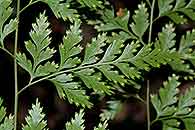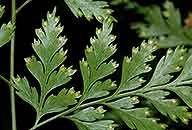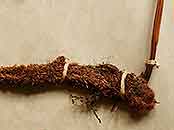Davallia chaerophylloides (Poir.) Steud.
Synonyms |
Davallia denticulata (Burm.f.) Mett. ex Kuhn var. intermedia Mett. ex Kuhn |
|---|---|
Common name |
|
Description |
Rhizome stout, woody, widely creeping, up to 15 mm in diameter; rhizome scales pale golden brown, peltate, narrowly lanceolate, hairpointed, up to 8 mm long with paler margins. Fronds widely spaced, arching, thinly coriaceous. Stipe 4-50 cm long, firm, wiry, glabrous at maturity, with scales similar to those on the rhizome at the extreme base. Lamina 16-90 × 13-50 cm, 4- to 5-pinnatifid, ovate-triangular in outline. Pinnae alternate, with petiole up to 3 cm long, triangular to oblong in outline; basal pinnae largest and developed basiscopically, others progressively smaller upwards. Ultimate segments pinnatifid into spathulate to cuneate lobes, obtuse, glabrous, distal margins deeply toothed. Rhachis and secondary rhachis glabrous, slightly winged towards the apices. Sori up to 2 mm in diameter, solitary, terminal on segments and on vein ends, variously subtented by 1 or 2 blunt or sharp teeth, covered by a pouchlike membranous, entire indusia. |
Notes | The combination of the finely divided fronds, the epiphytic or lithophytic habit and the cup-shaped sori separates this species from others. |
Derivation | chaerophylloides: like Chaerophyllum, a genus of the Apiaceae, whose finely divided leaves are not unlike those of this Davallia. |
Habitat | Moist and seasonally dry forest, mist forest, evergreen forest, saline and freshwater swamp forest, woodland. |
Distribution worldwide | Africa, Comoro and Mascarene islands, Madagascar, Seychelles; also Madeira, continental Asia, Malesia to Australia, Samoa and Tahiti. |
Distribution in Africa |
Angola, Benin, Burundi, Cameroon, Central African Republic, Dem. Republic of Congo, Equatorial Guinea (incl. Bioko), Gabon, Ghana, Guinea, Ivory Coast, Kenya, Liberia, Mozambique, Nigeria, Sierra Leone, South Africa, Sudan and South Sudan, Tanzania , Togo, Uganda, Zambia, Zimbabwe. |
Growth form |
Epiphytic, lithophytic. |
Literature |
|




